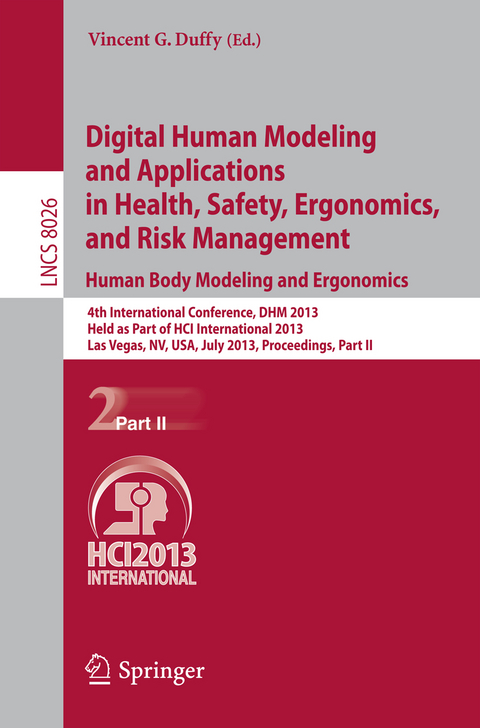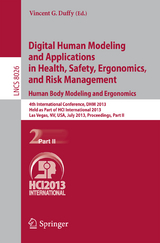Digital Human Modeling and Applications in Health, Safety, Ergonomics and Risk Management. Human Body Modeling and Ergonomics
Springer Berlin (Verlag)
978-3-642-39181-1 (ISBN)
Table of Contents - Part I.-Driving and Aviation Safety.- Human Centered Design of a Pre-collision System.- Causal Attribution and Control: Between Consciousness and Psychical Half-Shadow Application to Flight Operations.- Attentional Biases during Steering Behavior.- A Validation Approach for Complex NextGen Air Traffic Control Human Performance Models.- Personality and Attitudes as Predictors of Risky Driving Behavior: Evidence from Beijing Drivers.- Effects of Sleep Deprivation on Pilot's Cognitive Behavior in Flight Simulation.- Towards Early Status Warning for Driver's Fatigue Based on Cognitive Behavior Models.- Simulating the Impact of Mental Models on Human Automation Interaction in Aviation.-Ergonomics Study of Direct and Indirect Visibility Evaluation at Uncontrolled Intersections Based on Three-Dimensional Computer Simulation.- Prediction of Drowsy Driving Using Behavioral Measures of Drivers - Change of Neck Bending Angle and Sitting Pressure Distribution.- Effectiveness ofAutomotive Warning System Presented with Multiple Sensory Modalities.- Proposal of Automotive 8-directional Warning System That Makes Use. of Tactile Apparent Movement.- Evaluation of Drivers Interaction with Assistant Systems Using Criticality Driven Guided Simulation.- Effects of Spaceflight Operation Complexity and Training on Operation Error.- Predicating the Safety of Airport Approaches Using a Cognitive Pilot Model.- Human Factors and Digital Human Modeling in Healthcare.- Supporting Conversation for People with Dementia by Introducing a Computer-Based Third Element to the Interaction.- "Using Digital Interactive Television to Promote Healthcare and Wellness Inclusive Services".- Homecare Risk Management: Nursing Issues Related to Technology.- Facilitators' Intervention Variance and Outcome Influence When Using Video Games with Fibromyalgia Patients.- The Causal Analysis of Requested Alterations for Pressure Garments.- Towards Enhancing the Acoustic Models for Dysarthric Speech.- Supporting a Participant-Centric Management of Obesity via a Self-improving Health Game.- Feedback-Based Self-training System of Patient Transfer.- A Comparative Analysis of the Educational Effectiveness of Leaflet and Website for Low-Literate Patients - A Case Study of Immigrant Mothers in Taipei.- Effect Evaluation of Recreational Coloring Carried Out at Pay Nursing Home.- A Study for Conducting Waves by Using the Multi-channel Surface EMG.- Implementing Scenarios as an Evaluation Method of the Patient- Physician Interaction in Decision Aids.- Plantar Pressure Gradient Angles to Evaluate Risk of Diabetic Foot Ulcer .- Explicit Tracking in the Diagnostic Process for Hand Dermatological Practices.- Ideal Mode Selection of a Cardiac Pacing System.- Development of a Measurement and Evaluation System for Bed-Making Activity for Self-training.- Usability Problems in Patient- and Clinician-Oriented Health Information Systems: What Are They and How Do They Differ?.- Safety of the Human Environment.- AmI-Technology at Work - A Sociological Perspective Covering Aspects of Occupational Safety and Health (OSH).- Bayesian Affordance-Based Agent Model for Wayfinding Behaviors in Evacuation Problems.- A Sustainable Human Centered Design Framework Based on Human Factors.- Putting in Perspective Human-Machine System Theory and Modeling: From Theoretical Biology to Artifacts Integrative Design and Organization.- Friction Measurements in a Hand Tool Factory.- Development of Human Balance Assessment System with Continuous Center of Gravity Tracking.- Constructing Ergonomic Safety Modelling for Evaluating New Designs of Child Car Seats.- How Could This Have Happened? Unintentional Injuries of Young Children at Home.- Usability of Portable Fire Extinguisher: Perspectives of Ergonomics and Intuitive Use.- Adaptive User-Centered Design for Safety and Comfort of Physical Human Nursing - Care Robot Interaction.- Investigation of an Agent-Based Modeling on Crowd Evacuation and Its Application to Real Buildings.
| Erscheint lt. Verlag | 10.7.2013 |
|---|---|
| Reihe/Serie | Information Systems and Applications, incl. Internet/Web, and HCI | Lecture Notes in Computer Science |
| Zusatzinfo | XXVIII, 412 p. 169 illus. |
| Verlagsort | Berlin |
| Sprache | englisch |
| Maße | 155 x 235 mm |
| Gewicht | 650 g |
| Themenwelt | Mathematik / Informatik ► Informatik ► Betriebssysteme / Server |
| Informatik ► Software Entwicklung ► User Interfaces (HCI) | |
| Schlagworte | cognitive behavior modeling • dynamic workstations • human posture • User Modeling • virtual ergonomics |
| ISBN-10 | 3-642-39181-8 / 3642391818 |
| ISBN-13 | 978-3-642-39181-1 / 9783642391811 |
| Zustand | Neuware |
| Haben Sie eine Frage zum Produkt? |
aus dem Bereich




